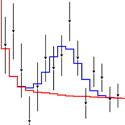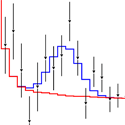A “bump” in the data
Particle colliders look for physics beyond the standard model by first verifying what the model predicts and then looking for deviations. If a new unstable particle is produced, it can decay into a pair of particles whose invariant mass is equal to the mass of that particle. So one of the simplest signals for physics beyond the standard model is an excess in the invariant mass distribution of a pair of particles in the final state of a collision, colloquially called a “bump” in the distribution.
While much of the attention in the particle physics community is focused on the Large Hadron Collider (LHC), the Fermilab collider is still the second highest energy machine in the world and has data on many more collisions than the LHC. Now, from an analysis of proton-antiproton collisions, the CDF collaboration (T. Aaltonen et al.) at Fermilab reports a curious excess in the number of events where there is a boson and a pair of jets with an invariant mass in the – range. Taking into account statistical and systematic errors, as well as the current understanding of the background, this “bump” in the data has a significance of standard deviations. The results are reported in Physical Review Letters.
What could the “bump” be? First, it could be a statistical fluctuation or systematic effect. But it could also result from the production and decay of a new particle. Various models for such a new particle have already been proposed, but the data does not correspond to a standard model Higgs boson (there are too many events in the “bump” for that and one would have expected more events with bottom-quark jets). So we await future analysis to pin down the nature of this intriguing feature in the data. – Robert Garisto





